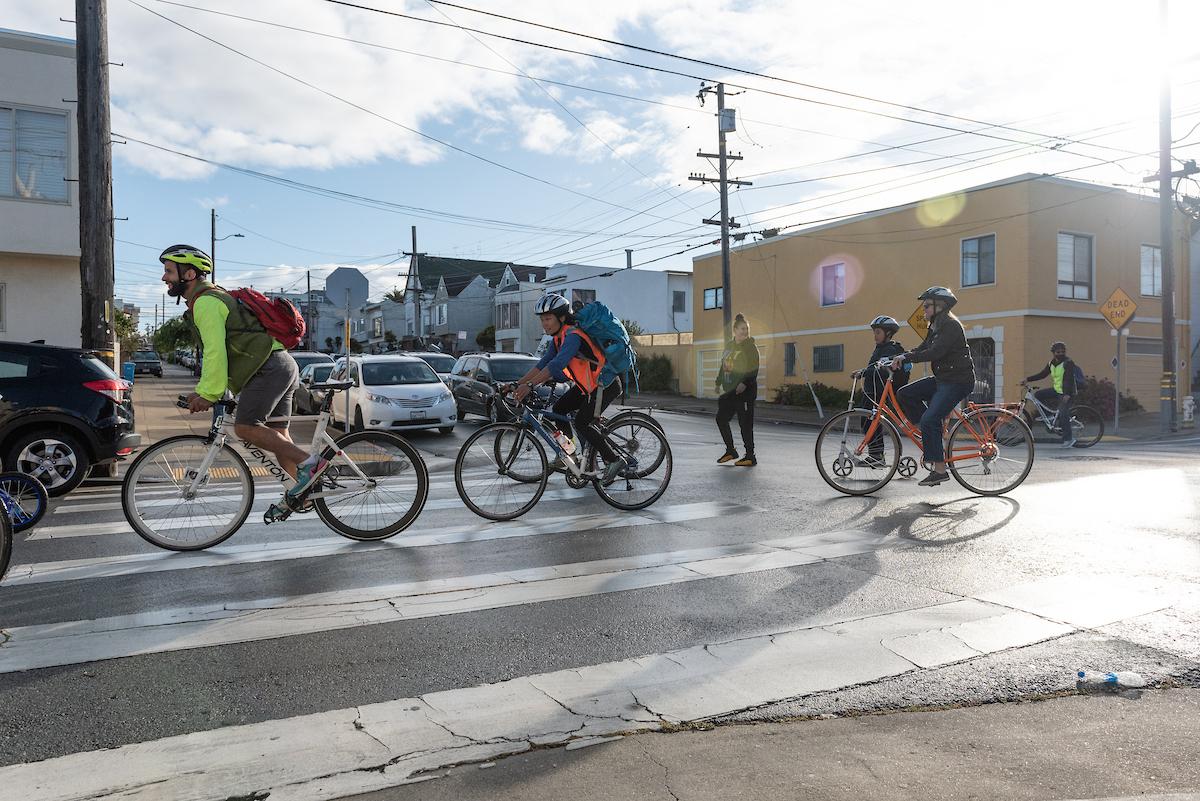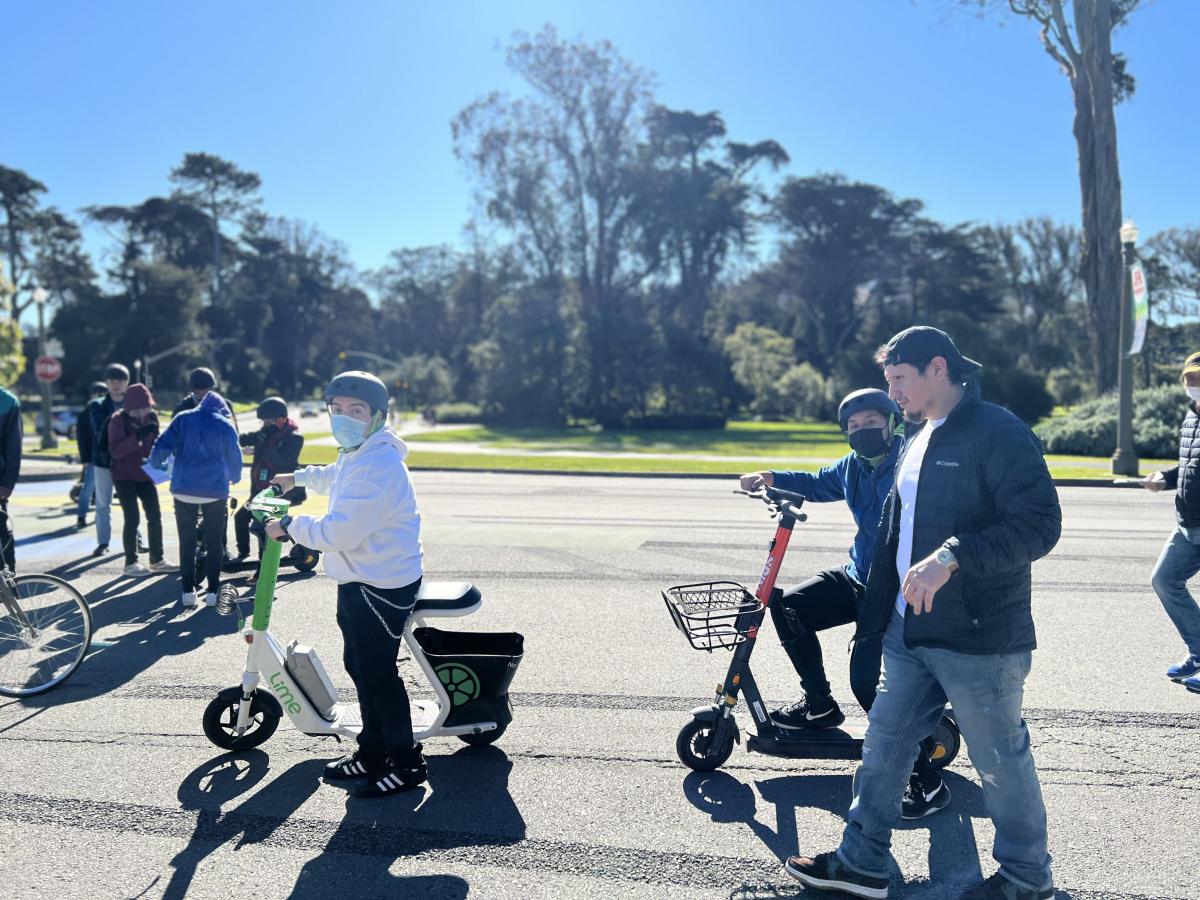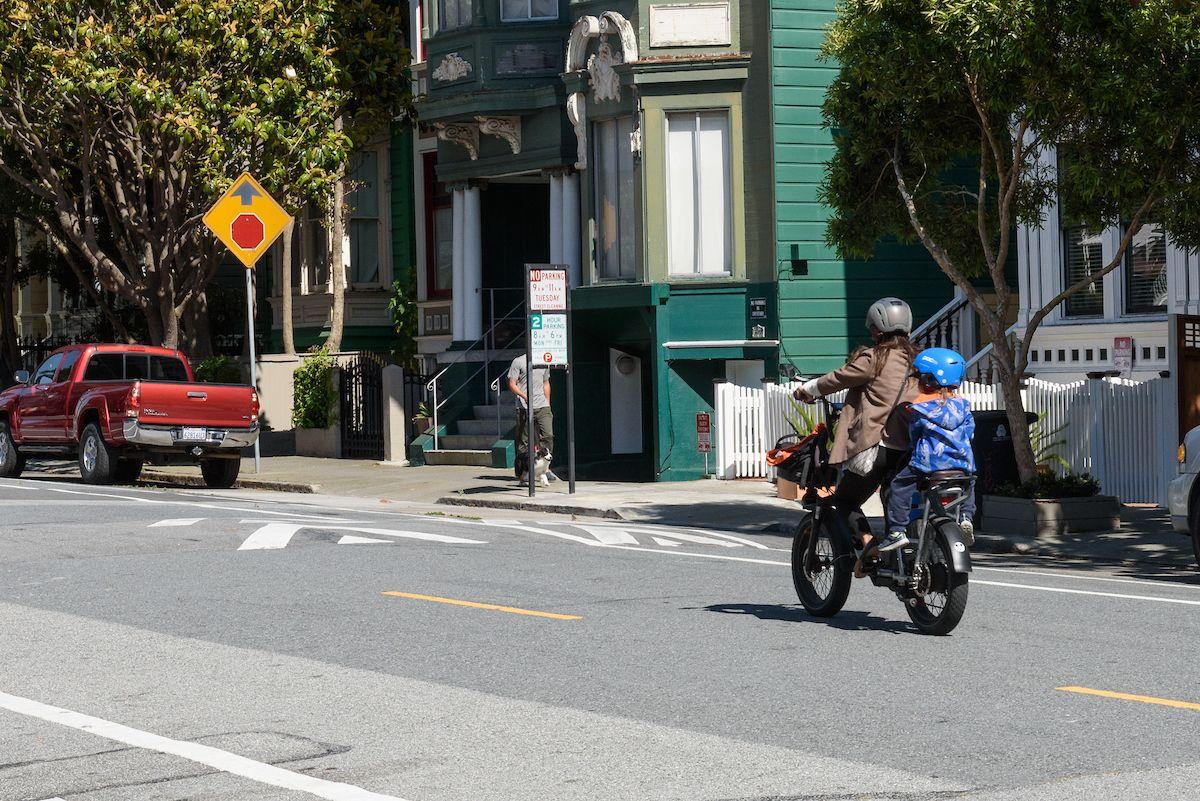
Help us create a city that’s safer and greener – watch this two-minute video about the draft Biking and Rolling Plan and how you can weigh in
On Tuesday, Nov. 19, we’ll share a first draft of San Francisco's Biking and Rolling Plan with the SFMTA Board and the public. The plan includes input from thousands of San Francisco residents we talked to over the last two years. We’re hoping to receive more feedback before the plan is formally adopted in early 2025.
By planning, we are laying the groundwork for the San Francisco we want to see develop over the next few decades—a city that is safer, greener, thriving and fair for everyone.
What is the Biking and Rolling Plan?
The Biking and Rolling Plan is San Francisco's blueprint for making biking and other forms of rolling, like riding scooters, e-bikes, skateboards, power chairs, and other low-speed wheeled devices, safer and more accessible for everyone in the city.
It sets out a long-range roadmap to create a safe, connected citywide biking and rolling network within a quarter mile of every San Franciscan that works for all ages and abilities. This will make biking or rolling an easy way to get to school, work, transit, errands and neighborhoods.
The plan includes:
- A North Star Map—an aspirational map that we can use as our long-term guide for where bike routes will go.
- Community Action Plan Summaries
- Examples of First-Stage Improvements — near-term safety and connectivity projects.
- The policies and programs that deliver the North Star network, together.
- Five goals that will guide investments to make biking and rolling safe and accessible for all:
- Goal 1: Putting People First
- Goal 2: Setting a North Star
- Goal 3: Serving Local Needs
- Goal 4: Delivering the Plan
- Goal 5: Resourcing People
The Biking and Rolling Plan is a living document. The plan will continue to evolve as the city changes and will be shaped by the needs of local communities.
The draft plan creates space for everyone. It expands travel options without removing cars from any drivable street. The draft network retains front-door access to every home and business in San Francisco by all modes of transport, including cars and delivery trucks.

We’re working to make it safer and easier to use e-bikes and scooters around the city.
Why do we need a plan for biking and rolling?
Cities need long-term transportation plans to prepare for the future. San Francisco expects major changes ahead. The city plans for more housing, healthy neighborhoods and vibrant small business districts. In 2009, planners created the last plan for San Francisco's bike network. At that time, e-bikes and scooters were rare.
The city has committed to building more than 80,000 new homes over the next decade. That will translate into about 150,000 more people traveling on city streets. There simply won’t be enough room on our streets for all those new city residents to drive everywhere. And not everyone will have the same access to driving. That's why we must make biking and rolling a safe, appealing option.
Even today, many people say they would bike and roll to get around if they felt safer doing it. About a third of city residents ride a bike, scooter, or other micromobility device at least once a week. Eighty percent of San Franciscans would like to bike or roll. But only 23% feel safe enough to do it.

The Biking and Rolling Plan would support all types of rolling, including with adaptive scooters.
How is this plan different from previous plans?
Previous bikeway planning hasn’t been inclusive of many people. That includes people with disabilities and people living in underserved communities. It also means people who need to make shorter trips around their neighborhoods. Past plans even excluded kids. They focused on men riding for fun or to work. Our updated plan makes clear that biking and rolling belong in San Francisco. It charts a path to a safe, inclusive network for all ages and abilities.
This plan faces the hard truths of past harms in our transport planning. Many San Francisco communities, including the Western Addition, Tenderloin, SoMa, Mission, Excelsior and Bayview Hunters Point, have been harmed by planning processes that excluded their needs and views. We aim to rebuild trust by creating this biking and rolling plan in partnership with these communities.
We are working with community organizations in the following neighborhoods to develop options that work for them:
- Bayview Hunters Point
- The Mission
- The Excelsior
- The Tenderloin
- The Western Addition
- The Fillmore
- SoMa
Residents in these neighborhoods feel less safe biking and rolling than those in other districts. They have less access to high-quality bikeways and limited secure bike parking.
Still, that doesn’t mean they want us to install a whole bunch of new bike lanes in their neighborhoods. We want to make sure the new bike lanes are accessible for everyone. Under this plan, we'll take more steps to help people understand how to use them — and the benefits. We'll offer programs and incentives to local residents. This will help build trust and create excitement around biking and rolling.
Our partners are Bayview Hunters Point Community Advocates, PODER Bicis del Pueblo, the Tenderloin Community Benefit District, New Community Leadership Foundation and SoMa Pilipinas. They are ensuring that the voices and perspectives of historically excluded communities are heard and that the plan prioritizes equity.
These organizations have developed or are in the process of developing community-based action plans for biking and rolling. These plans are based on their communities’ experiences, needs and readiness for change.
Who have we talked to, and how?
Over two years, we have worked with local groups to gather feedback that has informed the draft plan:
- Over 1,000 responses to our community survey
- Over 120 outreach events
- Over 40 community group 1:1 meetings and ongoing listening sessions
- 10 open house events with almost 500 attendees
- Six Policy Working Group sessions
- 10 Technical Advisory Committee meetings
- Over a dozen 1:1 meetings with businesses and merchants associations

Our new Biking and Rolling Plan would make it safer for families to bike and roll to school.
How do we get there?
The North Star map ensures that near-term projects build a connected network. It also shows where the network is likely to expand.
To reach the North Star, we'll propose projects to close network gaps, improve existing routes and enhance safety. We’ll work to make sure each one has minimal impact on residents. Every project would be publicly vetted and approved by the SFMTA Board.
For example, biking and rolling access to schools was one of the primary goals of the plan. Our proposals make sure families who are interested in biking and rolling to school will enjoy a safer and more pleasant experience than they do now.
We have also been partnering with local businesses. We recognize their vital role in San Francisco’s culture and economy. Many studies show that bikeways improve customer access and business growth. Yet, the Biking and Rolling plan recognizes that many small business owners feel overwhelmed by recent challenges.
This is especially true on narrow streets with transit, commercial loading, curbside parking and parklets. The plan does not propose adding new bikeways on merchant corridors. It recognizes each business district's unique needs. New bikeways are only proposed where there is strong support for better connections. Examples include Jefferson Street near Fisherman's Wharf and in West SoMa.
Our community partners have shared their needs with us. We will prioritize them and also take into account how ready communities are for change.
How to learn more and share your feedback
To learn more, you can read the draft plan or watch this short video explaining the plan.
To share ideas, you can email us your feedback at BikeRoll@SFMTA.com.
We also encourage you to come to the SFMTA Board of Directors meeting on Nov. 19. You’ll get to learn more about the biking and rolling plan and have the opportunity to provide your comments to our board members. They’re the people who will vote on the plan sometime before the end of February 2025.
Remember that this is a long-term plan. Any changes we propose, like new bike lanes, would need more community feedback for each project after the formal adoption of the plan in 2025. They would also need a separate Board of Directors vote.
Stay tuned for future blog posts. They will spotlight various community action plans and the stories behind them.